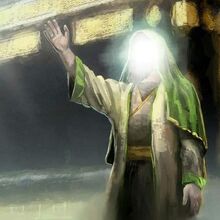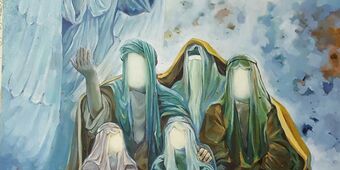Muhammad's wives
A total of eleven women are confirmed as having been married to Muhammad, the founder of Islam. As a sign of respect, Muslims refer to each of these wives with the title Umm al-Muʼminin (Arabic: أم ٱلْمُؤْمِنِين, lit. 'Mother of the Believers'), which is derived from 33:6 of the Quran.
Muhammad's first marriage was to Khadija bint Khuwaylid in 595, when he was 25 and she was either 28 or 41. She was his only wife until her death in 619 (the Year of Sorrow) ended their 24-year-long marriage. After Khadija, Muhammad went on to marry ten women: Sawdah bint Zam'ah in 619; Aisha bint Abi Bakr in 623; Hafsah bint Umar, Zaynab bint Khuzayma, and Hind bint Abi Umayya in 625; Zaynab bint Jahsh in 627; Juwayriya bint al-Harith and Ramla bint Abi Sufyan ibn Harb in 628; and Safiyya bint Huyayy and Maymunah bint al-Harith in 629. Additionally, the statuses of Rayhanah bint Zayd and Mariyya bint Shamʿun are disputed, as there has been disagreement among Muslim scholars on whether they were concubines or wives. With the exception of Aisha, all of these women were previously widowed or divorced. The common view is that Muhammad had seven biological children (three sons and four daughters) and all but one of them were produced with Khadija between 598 and 611 or 615. Mariyya bore Muhammad a son in 630 (his seventh child), but none of his sons survived to adulthood.
Traditionally, two epochs delineate Muhammad's life and career: pre-Hijrah Mecca between 570 and 622; and post-Hijrah Medina between 622 and his death in 632. "Hijrah" refers to Muhammad's migration, alongside the early Muslims, from Mecca to Medina due to the Meccans' persecution of the early Muslims. All but two of his marriages were contracted after this migration.
you can see Muhammad Rasool Allah Profile link
Muhammad's first wife Khadija
Khadija, Muhammad's first wife, was his employer and a woman of considerable wealth who reportedly supported him financially and emotionally, and she also became his first follower when he began preaching the message of Islam. Both her age and marital history at the time of her marriage to the 25-year-old Muhammad remain unclear; she was either 28 or 41 and may or may not have been a virgin, with the existence of any previous children also being disputed. Nonetheless, this marriage was the most significant by all accounts: six of Muhammad's seven biological children were produced with Khadija and the couple remained monogamous for the entirety of the 24 years that they were together. Khadija's death in 619, at the age of either 52 or 65, brought an end to the first marriage and the monogamy of Muhammad, who was 49 at this time. Upon his migration to Medina, he began actively practicing polygyny and acquired about one wife per year. He did not, however, have a Medinan wife, presumably because they did not embrace Islam's approval of marrying multiple women and its curtailment of their right to inheritance. Although Muslims are religiously limited to having only four wives at the same time, Muhammad was exempted from this ruling and was allowed to have an unlimited number of wives due to his status as an Islamic prophet and messenger. Additionally, Muhammad's wives were not allowed to remarry after his death; all men of the contemporary era were strictly warned against attempting to marry these widowed women, with this intent being classified as "a major offence in the sight of Allah" in the Quran.
Scottish academic William Montgomery Watt states that all of Muhammad's marriages had the political aspect of strengthening friendly relationships and were based on the Arabian custom. American professor John Esposito points out that some of Muhammad's marriages were aimed at providing a livelihood for widows; he noted that remarriage was difficult for these women in Arabian society, which emphasized and was hyper-focused on female virginity and sexual purity. American academic Francis Edward Peters says that it is hard to make generalizations about Muhammad's marriages; many of them were political, some compassionate, and some perhaps affairs of the heart. American historian John Victor Tolan writes that Muhammad's marriages were mainly attempts at forging political alliances.
Thus, the objectives of Muhammad's marriages have been described as:
Creating family bonds between him and his companions (Muhammad married the daughters of Abu Bakr and Umar, whereas Uthman and Ali married his daughters. He therefore had family bonds with all of the Rashidun).
Spreading the message of Islam by uniting different Arabian tribes and clans through marriage.
Terminology
"Mother of the Believers" is a term by which each of Muhammad's wives came to be prefixed with over time. It is derived from Quran 33:6: "The Prophet is closer to the believers than their selves, and his wives are (as) their mothers" is applied to all of these women.
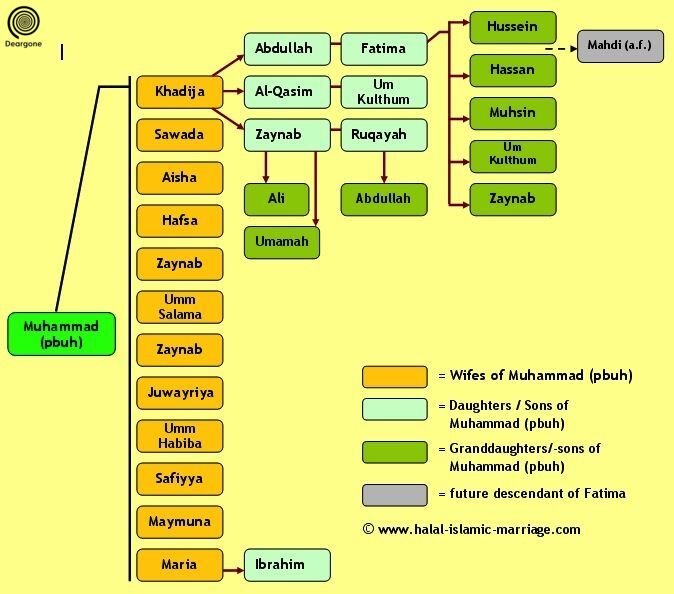
Family life of Muhammad Rasool Allah
Muhammad and his family lived in small apartments adjacent to the mosque at Medina. Each of these were six to seven spans wide (1.7 metres) and ten spans long (2.3 meters), and the height of the ceiling was equivalent to that of an average man standing. Blankets were used as curtains to screen the doors. According to an account by Anas ibn Malik, one of Muhammad's companions: "The Prophet used to visit all his wives in a round, during the day and night and they were eleven in number." I asked Anas, "Had the Prophet the strength for it?" Anas replied, "We used to say that the Prophet was given the strength of thirty (men)." And Sa'id said on the authority of Qatada that Anas had told him about nine wives only (not eleven).
Although Muhammad's wives had a special status among the early Muslims, he did not allow them to use his status as a prophet and messenger to obtain special treatment in public.
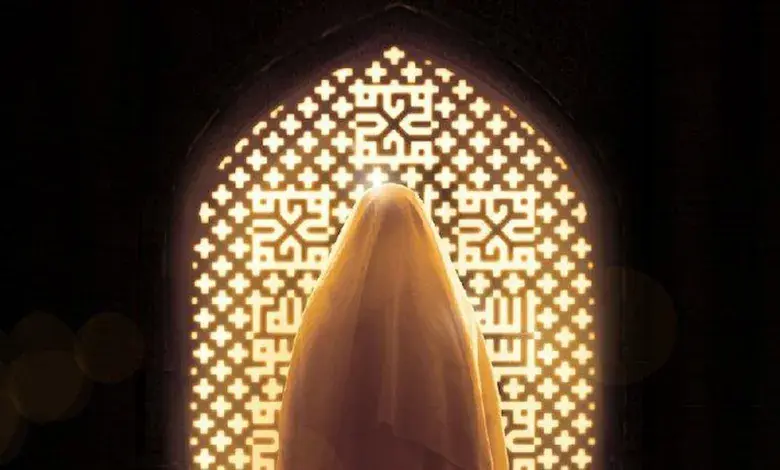
Marriages Khadija bint Khuwaylid
Around the age of 25, Muhammad wed his wealthy employer, Khadija, the 28-or 40-year-old widow, and daughter of a merchant. Muhammad used to manage her caravans; and Khadija, being impressed by the skills of Muhammad, sent a proposal to the Islamic prophet.Around 595, the couple married, and this marriage, his first, would be both happy and monogamous; Muhammad would rely on Khadija in many ways, until her death 25 years later. They had two sons, Qasim and Abd Allah (nicknamed al-Ṭāhir and al-Ṭayyib respectively),[26] both died young, and four daughters—Zaynab, Ruqaiya, Umm Kulthum and Fatimah. Some Shia scholars dispute the paternity of Khadija's daughters, as they view the first three of them as the daughters from previous marriages and only Fatimah as the daughter of Muhammad and Khadija. During their marriage, Khadija purchased the slave Zayd ibn Harithah, then adopted the young man as her son at Muhammad's request.Muhammad's uncle Abu Talib and Khadija died in 620 and the Islamic prophet declared the year as Aam al-Huzn ('Year of Sorrow').
Sawda bint Zamʿah wife Of Muhammad
Before he left for Medina, it was suggested by Khawlah bint Hakim that he should marry Sawdah bint Zam'ah, who had suffered many hardships after she became a Muslim. Prior to that, Sawdah was married to a paternal cousin of hers named As-Sakran ibn ‘Amr and had five or six children from her previous marriage. She along with her husband migrated to Abyssinia due to persecution of Muslims by Meccans. Her husband died in Abyssinia and hence Sawdah had to come back to Mecca. There are disagreements in Muslim tradition whether Muhammad first married Sawdah or Aisha, but Sawda is usually regarded as his second wife and she was living with him before Aisha joined the household.Sawda was about 30 years old at the time.
As Sawdah got older, and some time after Muhammad's marriage to Umm Salama, there are reports that Muhammad was neglecting Sawdah and had planned to divorce her. But Sawdah stopped him in the street and begged him to take her back, offering to give up her turn for his nightly conjugal visits to Aisha, whom he was very fond of.Sawdah pleaded that she was old anyway and did not care for men; her only wish was to be resurrected as the Prophet's wife on the Day of Judgment. Muhammad agreed to her proposal, and Qur'an 4:128-9 was revealed. Other traditions say that Muhammad did not really reject her, but that she was afraid that he would, and it was not rejection that was considered in the revelation of the verse, but rather a compromise on divorce so long as she could remain his wife in name.

Aisha bint Abu Bakr wife of Muhammad Rasool Allah
Aisha was the daughter of Muhammad's close friend Abu Bakr. She was initially betrothed to Jubayr ibn Muṭʽim, a Muslim whose father, though pagan, was friendly to the Muslims. When Khawlah bint Hakim suggested that Muhammad marry Aisha after the death of Muhammad's first wife (Khadija), the previous agreement regarding the marriage of Aisha with ibn Mut'im was put aside by common consent.
Muhammad converted friendship of his four friends who later became the four Islamic rulers or successors, into relationship through marriage. He married Aisha and Hafsa daughters of Abu Bakr and Umar and he gave his daughters to Uthman and Ali. Aisha was the only virgin he married.
The majority of traditional sources state that Aisha was betrothed to Muhammad at the age of six or seven, but she stayed in her parents' home until the age of nine, or ten according to Ibn Hisham, when the marriage was consummated with Muhammad, then 53, in Medina. Aisha's age at marriage has been a source of controversy and debate, and many non-Muslim historians, Islamic scholars, and Muslim writers have challenged the previously accepted timeline of her life by claiming that Aisha was in fact 18-19 years old when she consummated her marriage to Muhammad according to historical reviews. Both Aisha and Sawda, his two wives, were given apartments adjoined to the Al-Masjid al-Nabawi mosque.
Aisha was extremely scholarly and inquisitive. Her contribution to the spread of Muhammad's message was extraordinary, and she served the Muslim community for 44 years after his death. She is also known for narrating 2210 hadith, not just on matters related to Muhammad's private life, but also on topics such as marriage, Islamic inheritance, Hajj and Islamic eschatology, among other subjects. She was highly regarded for her intellect and knowledge in various fields, including poetry and medicine, which received plenty of praise by the traditionist al-Zuhri and by her student Urwa ibn al-Zubayr. Aisha was also a general who led thousands of Muslims to battle during the First Fitna.
Hafsa bint Umar and Zaynab bint Khuzayma
During the Muslim war with Mecca, many men were killed leaving behind widows and orphans. Hafsa bint Umar, daughter of Umar ibn Al-Khattab, was widowed at Battle of Badr when her husband Khunais ibn Hudhaifa was killed in action. Muhammad married her in 3 A.H./625 CE. Zaynab bint Khuzayma was also widowed at the battle of Badr. She was the wife of Ubaydah ibn al-Harith, a faithful Muslim and from the tribe of Al-Muttalib, for which Muhammad had special responsibility.When her husband died, Muhammad aiming to provide for her, married her in 4 A.H. She was nicknamed Umm Al-Masakeen (roughly translates as the mother of the poor), because of her kindness and charity.
Close to Aisha's age, the two younger wives Hafsa and Zaynab were welcomed into the household. Sawda, who was much older, extended her motherly benevolence to the younger women. Aisha and Hafsa had a lasting relationship. As for Zaynab, however, she became ill and died about three months after her marriage.
Hind bint Suhayl (Umm Salama) wife of Muhammad
The death of Zaynab coincided with that of Abu Salamah, a devout Muslim and Muhammad's foster brother, as a result of his wounds from the Battle of Uhud. Abu Salamah's widow, Umm Salama, also a devoted Muslim, had none but her young children. Her plight of being without a man reportedly saddened the Muslims, and after her iddah some Muslims proposed marriage to her; but she declined. She was the paternal cousin of Khalid Ibn Al Waleed, the military commander who fought against Muhammad in many battles. Her marriage made Khalid take an indecisive attitude at the battle of Uhud. When Muhammad proposed her marriage, she was reluctant for three reasons: she claimed to suffer from jealousy and pointed out the prospect of an unsuccessful marriage, her old age, and her young family that needed support. But Muhammad replied that he would pray to God to free her from jealousy, that he too was of old age, and that her family was like his family.She married Muhammad around the end of 4 AH.
Rayhana bint Zayd wife of Muhammad
Rayhana bint Zayd was a Jewish woman from the Banu Nadir tribe. In 627, the Banu Qurayza tribe was defeated and Rayhana was enslaved. Ibn Sa'd wrote that Rayhana went on to be manumitted and subsequently married to the prophet upon her conversion to Islam. Al-Tha'labi reports that the prophet paid a mahr for her and Ibn Hajar makes reference to Muhammad giving Rayhana a home upon their marriage.
Internal dissension
An incident happened in which Aisha left her camp to search for her lost necklace, and returned with a companion of Muhammad.

Zaynab bint Jahsh
Zaynab bint Jahsh was Muhammad's cousin, the daughter of one of his father's sisters.
In the Pre Islamic Era, Arabs used to consider children who had been sponsored exactly the same as their biological children as far as rights such as inheritance and sanctities were concerned. However, after marriage the sponsored children lost their inheritance rights and were henceforth known as the children of their biological parents. After attaining puberty, they could not live with the sponsoring family but were still subsidised. This was to reduce the enmity of biological children towards sponsored children and to prevent the mingling of male sponsors with adult sponsored females.
In Medina Muhammad arranged the widowed Zaynab's marriage to his adopted son Zayd ibn Harithah. Caesar E. Farah states that Muhammad was determined to establish the legitimacy and right to equal treatment of the adopted. Zaynab disapproved of the marriage, and her brothers rejected it, because according to Ibn Sa'd, she was of aristocratic lineage and Zayd was a former slave. Watt states that it is not clear why Zaynab was unwilling to marry Zayd as Muhammad esteemed him highly. He postulates that Zaynab, being an ambitious woman, was already hoping to marry Muhammad; or that she might have wanted to marry someone of whom Muhammad disapproved for political reasons. According to Maududi, after the Qur'anic verse 33:36 -Tafhim-ul-Quran was revealed, Zaynab acquiesced and married Zayd.
Zaynab's marriage was unharmonious. According to Watt, it is almost certain that she was working for marriage with Muhammad before the end of 626. "Zaynab had dressed in haste when she was told 'the Messenger of God is at the door.' She jumped up in haste and excited the admiration of the Messenger of God, so that he turned away murmuring something that could scarcely be understood. However, he did say overtly: 'Glory be to God the Almighty! Glory be to God, who causes the hearts to turn!'"Zaynab told Zayd about this, and he offered to divorce her, but Muhammad told him to keep her.[31] The story laid much stress on Zaynab's perceived beauty. Nomani considers this story to be a rumor.Watt doubts the accuracy of this portion of the narrative since it does not occur in the earliest source. He thinks that even if there is a basis of fact underlying the narrative, it would have been subject to exaggeration in the course of transmission as the later Muslims liked to maintain that there was no celibacy and monkery in Islam.Rodinson disagrees with Watt arguing that the story is stressed in the traditional texts and that it would not have aroused any adverse comment or criticism.
Muhammad, fearing public opinion, was initially reluctant to marry Zaynab. The marriage would seem incestuous to their contemporaries because she was the former wife of his adopted son, and adopted sons were considered the same as biological sons. According to Watt, this "conception of incest was bound up with old practices belonging to a lower, communalistic level of familial institutions where a child's paternity was not definitely known; and this lower level was in process being eliminated by Islam." The Qur'an 33:37 however, indicated that this marriage was a duty imposed upon him by God. It implied that treating adopted sons as real sons was objectionable and that there should now be a complete break with the past. Thus Muhammad, confident that he was strong enough to face public opinion, proceeded to reject these taboos. When Zaynab's waiting period was complete, Muhammad married her.An influential faction in Medina, called "Hypocrites", a term that refers to those who convert to Islam while secretly working against it in the Islamic tradition, did indeed criticize the marriage as incestuous. Attempting to divide the Muslim community, they spread rumors as part of a strategy of attacking Muhammad through his wives. According to Ibn Kathir, the relevant Qur'anic verses were a "divine rejection" of the Hypocrites' objections. According to Rodinson, doubters argued the verses were in exact conflict with social taboos and favored Muhammad too much. The delivery of these verses, thus, did not end the dissent.
Juwayriya bint al-Harith
One of the captives from the skirmish with the Banu Mustaliq was Juwayriya bint al-Harith, who was the daughter of the tribe's chieftain. Her husband, Mustafa bin Safwan, had been killed in the battle. She initially fell among the booty of Muhammad's companion Thabit ibn Qays ibn Al-Shammas. Upon being enslaved, Juwayriyya went to Muhammad requesting that she - as the daughter of the lord of the Mustaliq - be released, however, he refused. Meanwhile, her father approached Muhammad with ransom to secure her release, but Muhammed still refused to release her. Muhammad then offered to marry her, and she accepted. When it became known that tribes persons of Mustaliq were kinsmen of the prophet of Islam through marriage, the Muslims began releasing their captives. Thus, Muhammad's marriage resulted in the freedom of nearly one hundred families whom he had recently enslaved.
Safiyya bint Huyayy Ibn Akhtab Wife Of Muhammad
Safiyya bint Huyayy was a noblewoman and the daughter of Huyayy ibn Akhtab, the chief of the Jewish tribe Banu Nadir, who was executed after surrendering at the Battle of the Trench.She had been married first to the poet Sallam ibn Mishkam, who had divorced her, and second to Kenana ibn al-Rabi, a commander.
In 628, Muhammad attacked Khaybar and made the inhabitants, including the Banu Nadir, surrender. Kenana, who was Safiyya's husband at the time, was tortured and then beheaded after he refused to reveal the location of his tribe's treasure.One of Muhammad's companions, Dihya al-Kalbi, asked Muhammad to be allowed to take a slave girl from the captives; he gave permission, so Dihya went and took Safiyya. However, a man then came to Muhammad reporting that Dihya had taken Safiyya, who was the chief mistress of the Qurayza and the Nadir, which he thought was only suitable for Muhammad. Thus, Muhammad gave the order to call them.
When Safiyya was brought, she was with another woman, and when the woman saw the headless bodies, she screamed wildly, struck herself in the face, and poured sand on her own head.The woman was taken away, Muhammad then took Safiyya for himself and told Dihya to take any other slave girl from the captives. Reportedly, Dihya got seven slaves in exchange.After that, Muhammad married her and brought her into his bed that very night. She was 17 years old at the time and was known to be exceptionally beautiful.
According to Martin Lings, Muhammad had given Safiyyah the choice of returning to the defeated Banu Nadir, or becoming Muslim and marrying him, and Safiyyah opted for the latter choice. W. Montgomery Watt and Nomani believe that Muhammad married Safiyya as part of reconciliation with the Jewish tribe and as a gesture of goodwill. John L. Esposito states that the marriage may have been political or to cement alliances. Haykal opines that Muhammad's manumission of and marriage to Safiyaa was partly in order to alleviate her tragedy and partly to preserve their dignity, and compares these actions to previous conquerors who married the daughters and wives of the kings whom they had defeated. According to some, by marrying Safiyyah, Muhammad aimed at ending the enmity and hostility between Jews and Islam.
Muhammad convinced Safiyya to convert to Islam.According to Abu Ya'la al-Mawsili, Safiyya came to appreciate the love and honor Muhammad gave her, and said, "I have never seen a good-natured person as the Messenger of Allah".Safiyyah remained loyal to Muhammad until he died.
According to Islamic tradition, Safiyya was beautiful, patient, intelligent, learned and gentle, and she respected Muhammad as "Allah's Messenger". Muslim scholars state she had many good moral qualities. She is described as a humble worshiper and a pious believer. Ibn Kathir said, "she was one of the best women in her worship, piousness, ascetism, devoutness, and charity". According to Ibn Sa'd, Safiyyah was very charitable and generous. She used to give out and spend whatever she had; she gave away a house that she had when she was still alive.
Upon entering Muhammad's household, Safiyya became friends with Aisha and Hafsa. Also, she offered gifts to Fatima. She gave some of Muhammad's other wives gifts from her jewels that she brought with her from Khaybar. However, some of Muhammad's other wives spoke ill of Safiyya's Jewish descent. Muhammad intervened, pointing out to everyone that Safiyya's "husband is Muhammad, father is Aaron, and uncle is Moses", a reference to revered prophets.
Muhammad once went to hajj with all his wives. On the way, Safiyya's camel knelt down, as it was the weakest in the caravan, and she started to weep. Muhammad came to her and wiped her tears with his dress and hands, but the more he asked her not to cry, the more she went on weeping. When Muhammad was terminally ill, Safiyya was profoundly upset. She said to him "I wish it was I who was suffering instead of you."
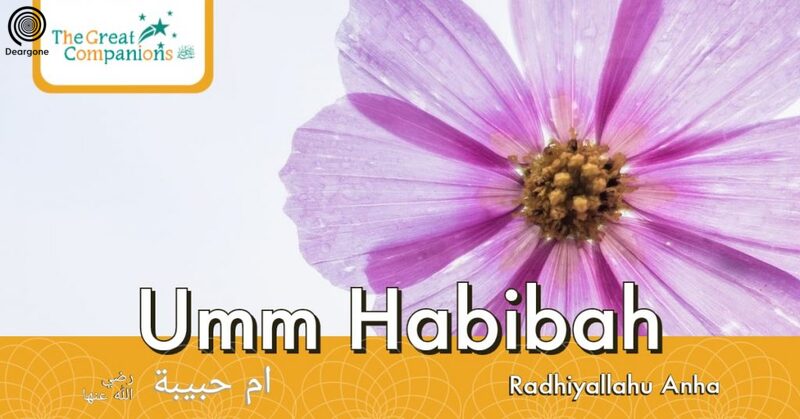
Ramla bint Abi Sufyan (Umm Habiba)
In the same year, Muhammad signed a peace treaty with his Meccan enemies, the Quraysh effectively ending the state of war between the two parties. He soon married the daughter of the Quraysh leader and military commander, Abu Sufyan ibn Harb, aimed at further reconciling his opponents. He sent a proposal for marriage to Ramla bint Abi Sufyan, who was in Abyssinia at the time when she learned her husband had died. She had previously converted to Islam (in Mecca) against her father's will. After her migration to Abyssinia her husband had converted to Christianity. Muhammad dispatched 'Amr bin Omaiyah Ad-Damri with a letter to the Negus (king), asking him for Umm Habiba's hand—that was in Muharram, in the seventh year of Al-Hijra.
Mariyah bint Shamoon al-Qibtiya
Maria al-Qibtiyya was one of several slaves whom the Governor of Egypt sent as a present to Muhammad. He kept her as a concubine despite the objections of his official wives. It is said in early biographies of Muhammad that Mariyah is a slave girl or concubine. Mariyah bore Muhammad a son, Ibrahim who later died at 18 months.
Maymuna binti al-Harith
As part of the treaty of Hudaybiyah, Muhammad visited Mecca for the pilgrimage. There Maymuna bint al-Harith proposed marriage to him. Muhammad accepted, and thus married Maymuna, the sister-in-law of Abbas, a longtime ally of his. By marrying her, Muhammad also established kinship ties with the banu Makhzum, his previous opponents. As the Meccans did not allow him to stay any longer, Muhammad left the city, taking Maymuna with him. Her original name was "Barra" but he called her "Maymuna", meaning the blessed, as his marriage to her had also marked the first time in seven years when he could enter his hometown Mecca.

